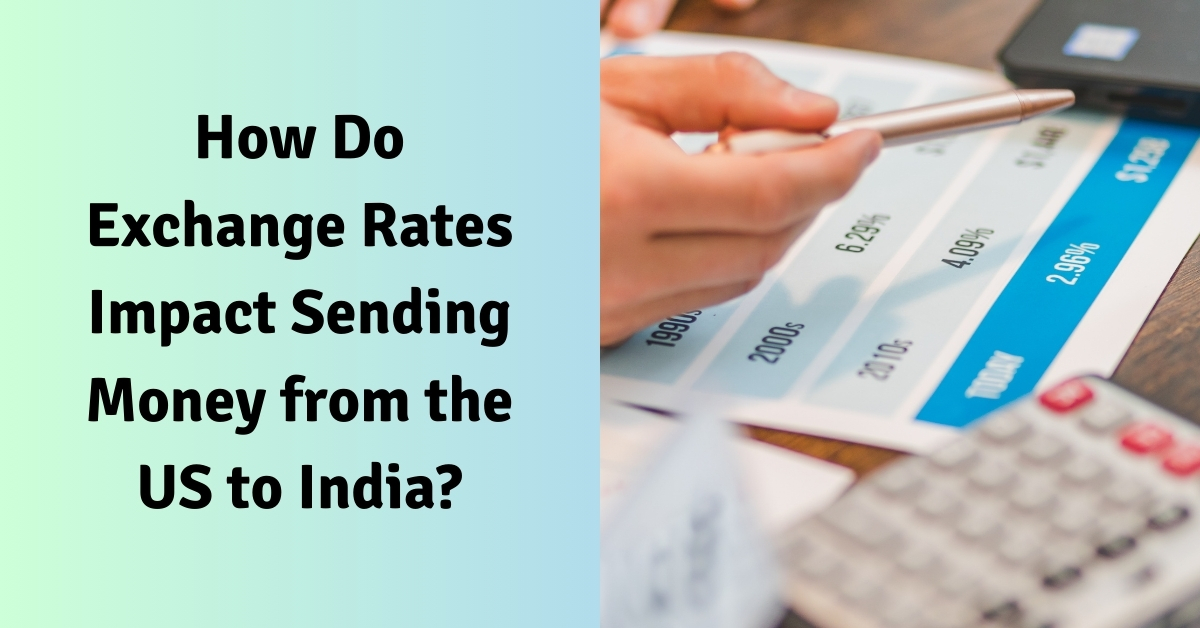How Do Exchange Rates Impact Sending Money from the US to India?

When the Indian rupee gets weaker, it can be good or bad. People from India living abroad and Indian businesses selling things to other countries can make more money when they change foreign money into rupees.
But for people from other countries visiting India or Indian students living in the US, this can be a problem because things cost more in dollars.
Changes in how much one money is worth compared to another can really change how much money you get when sending it to another country. We’ll talk about how these changes affect money sent home, what makes money values change, and how to get the best deal when changing dollars to rupees.
What’s an Exchange Rate?
An exchange rate is how much of one kind of money you get when you trade it for another kind.
This rate is really important because it decides how many rupees you’ll get for each dollar.
There are two main types of exchange rates:
Fixed: This kind doesn’t change much, which is good for businesses working with other countries because they know what to expect. Floating: This kind can change by itself when things happen in the world. This can help fix problems with trade and handle big changes in world money better.
What Makes Exchange Rates Change?
Different things can change how much one money is worth compared to another:
- How Well the Country Is Doing This means how much stuff a country is making and buying. If a country is doing well, its money usually gets stronger.
Things like how much factories are making, how much people are buying, and how much a country is trading with others show how well it’s doing.
- Interest Rates These are set by a country’s main bank. They affect how much it costs to borrow money and how much you can earn by saving or investing.
Higher interest rates usually make a country’s money stronger because people want to put their money there to earn more.
- How Much the Whole Country Makes (GDP) This is the total value of everything a country makes and sells. If this number is high, it usually means the country is doing well and its money gets stronger.
- How Many People Don’t Have Jobs This shows how many people who want to work can’t find jobs. If not many people are out of work, it usually means the country is doing well and its money gets stronger.
- What People Think Will Happen This is about people who buy and sell money trying to guess what will happen next. Their guesses can make money values change quickly.
- How Fast Prices are Going Up This measures how fast things are getting more expensive. If prices aren’t going up fast, it usually makes the country’s money stronger.
- How Much a Country Buys and Sells to Other Countries If a country sells more to other countries than it buys, its money usually gets stronger. If it buys more than it sells, its money usually gets weaker.
How to Get the Best Deal When Sending Money Home
Here are some tips to help you get more rupees for your dollars:
- Check Often: Money values change a lot, so look at them regularly.
- Use Alerts: Some apps can tell you when money values are good.
- Compare Fees: Different companies charge different amounts for sending money.
- Watch for Hidden Costs: Some companies might have extra fees they don’t tell you about right away.
- Avoid Busy Times: Sometimes, like during holidays, you might not get as good a deal.
- Lock in Good Rates: Some companies let you keep today’s good rate for future money sends.
- Use Online Services: These often give you better deals than regular banks.
- Look for Easy Ways: Online services let you send money anytime, anywhere.
- Find Discounts: Some companies give you better deals if you use them a lot or have special offers.
Conclusion
How much money is worth when you send it from the US to India can change. It’s important to know what makes these changes happen, like how well countries are doing, how much interest banks give, how much a whole country makes, and how fast prices go up.
It’s also important to watch how much money is worth, look at different ways to send money, and pick the right time to send money to get the most rupees for your dollars.
FAQs
Q1. Why does how much money is worth keep changing? Ans- Money values change because of things like how well countries are doing, how much interest banks give, how steady the government is, and what people think will happen. These things make people want to buy or sell different kinds of money.
Q2. How often does how much money is worth change? Ans- Money values can change every day or even every hour. It depends on what’s happening in the world and with money.
Q3. Do all ways of sending money give you the same amount of rupees for your dollars? Ans- No, different ways of sending money give you different amounts of rupees for your dollars and charge different fees. So it’s important to look at different ways before you choose one.
Q4. Can you keep today’s good money value for sending money later? Ans- Yes, some ways of sending money let you keep today’s good money value for sending money on a later day. This helps you avoid getting less if the money value changes.
Q5. How can the difference between buying and selling money values affect how much money you send? Ans- The difference between how much companies buy and sell money for can make you get less money. A smaller difference means you get more rupees for your dollars.
Q6. What happens to remittances when the US dollar is strong?
Ans- When the US dollar is strong, each dollar sent to India converts to more rupees, giving the recipient more money without extra cost to the sender.
Q7. How does inflation in India affect exchange rates?
Ans- High inflation in India can weaken the rupee, meaning you get more rupees per dollar sent, which is beneficial for those sending money to India.
Q8. How do political events affect exchange rates and remittances?
Ans- Events like elections or conflicts can create uncertainty, causing exchange rates to change. This can result in either more or less money received when sending remittances.
Q9. When is the best time to check exchange rates for sending money?
Ans- Exchange rates change throughout the day and week. It’s usually better to check rates during off-peak hours and avoid weekends when rates might not be as good.
Q10. How can you avoid losing money from exchange rate changes when sending a large amount?
Ans- You can use options like forward contracts or limit orders to lock in a good rate or set a target rate, ensuring you get the best deal for large money transfers.



